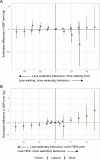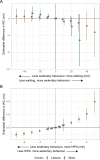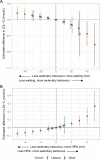The physical activity health paradox and risk factors for cardiovascular disease: A cross-sectional compositional data analysis in the Copenhagen City Heart Study
- PMID: 35446893
- PMCID: PMC9022831
- DOI: 10.1371/journal.pone.0267427
The physical activity health paradox and risk factors for cardiovascular disease: A cross-sectional compositional data analysis in the Copenhagen City Heart Study
Abstract
Background: Studies indicate that physical activity during leisure and work have opposite associations with cardiovascular disease (CVD) risk factors, referred to as the physical activity health paradox. We investigated how sedentary behaviour and physical activity types during leisure and work are associated with systolic blood pressure (SBP), waist circumference (WC), and low-density lipoprotein cholesterol (LDL-C) in an adult general population sample using compositional data analysis.
Methods: Participants wore accelerometers for 7 days (right thigh and iliac crest; 24 h/day) and had their SBP, WC, and LDL-C measured. Accelerometer data was analysed using the software Acti4 to derive daily time spent in sedentary behaviour and physical activity types. The measure of association was quantified by reallocating time between sedentary behaviour and 1) walking, and 2) high-intensity physical activity (HIPA; sum of climbing stairs, running, cycling, and rowing), during both domains.
Results: In total, 652 participants were included in the analyses (median wear time: 6 days, 23.8 h/day). During leisure, the results indicated that less sedentary behaviour and more walking or more HIPA was associated with lower SBP, while during work, the findings indicated an association with higher SBP. During both domains, the findings indicated that less sedentary behaviour and more HIPA was associated with a smaller WC and lower LDL-C. However, the findings indicated less sedentary behaviour and more walking to be associated with a larger WC and higher LDL-C, regardless of domain.
Conclusions: During leisure, less sedentary behaviour and more walking or HIPA seems to be associated with a lower SBP, but, during work, it seems to be associated with a higher SBP. No consistent differences between domains were observed for WC and LDL-C. These findings highlight the importance of considering the physical activity health paradox, at least for some risk factors for CVD.
Conflict of interest statement
The authors have declared that no competing interests exist.
Figures




Similar articles
-
Can we walk away from cardiovascular disease risk or do we have to 'huff and puff'? A cross-sectional compositional accelerometer data analysis among adults and older adults in the Copenhagen City Heart Study.Int J Behav Nutr Phys Act. 2020 Jul 6;17(1):84. doi: 10.1186/s12966-020-00985-w. Int J Behav Nutr Phys Act. 2020. PMID: 32631371 Free PMC article.
-
Time spent cycling, walking, running, standing and sedentary: a cross-sectional analysis of accelerometer-data from 1670 adults in the Copenhagen City Heart Study : Physical behaviours among 1670 Copenhageners.BMC Public Health. 2019 Oct 24;19(1):1370. doi: 10.1186/s12889-019-7679-z. BMC Public Health. 2019. PMID: 31651272 Free PMC article.
-
Cross-Sectional Associations of Reallocating Time Between Sedentary and Active Behaviours on Cardiometabolic Risk Factors in Young People: An International Children's Accelerometry Database (ICAD) Analysis.Sports Med. 2018 Oct;48(10):2401-2412. doi: 10.1007/s40279-018-0909-1. Sports Med. 2018. PMID: 29626333 Free PMC article.
-
Replacing Sedentary Time: Meta-analysis of Objective-Assessment Studies.Am J Prev Med. 2018 Sep;55(3):395-402. doi: 10.1016/j.amepre.2018.04.042. Am J Prev Med. 2018. PMID: 30122216 Review.
-
Cardiovascular risk factors among nurses: A global systematic review and meta-analysis.PLoS One. 2024 Mar 21;19(3):e0286245. doi: 10.1371/journal.pone.0286245. eCollection 2024. PLoS One. 2024. PMID: 38512844 Free PMC article.
Cited by
-
The association between reallocations of time and health using compositional data analysis: a systematic scoping review with an interactive data exploration interface.Int J Behav Nutr Phys Act. 2023 Oct 19;20(1):127. doi: 10.1186/s12966-023-01526-x. Int J Behav Nutr Phys Act. 2023. PMID: 37858243 Free PMC article.
-
Speckle tracking echocardiography for prediction of arrhythmias in idiopathic ventricular fibrillation.Eur Heart J Imaging Methods Pract. 2025 Aug 13;3(2):qyaf099. doi: 10.1093/ehjimp/qyaf099. eCollection 2025 Jul. Eur Heart J Imaging Methods Pract. 2025. PMID: 40810113 Free PMC article.
-
Trajectories of occupational physical activity and risk of later-life mild cognitive impairment and dementia: the HUNT4 70+ study.Lancet Reg Health Eur. 2023 Aug 29;34:100721. doi: 10.1016/j.lanepe.2023.100721. eCollection 2023 Nov. Lancet Reg Health Eur. 2023. PMID: 37927437 Free PMC article.
-
Reallocating just 10 min to moderate-to-vigorous physical activity from other components of 24-hour movement behaviors improves cardiovascular health in adults.BMC Public Health. 2024 Jul 3;24(1):1768. doi: 10.1186/s12889-024-19255-6. BMC Public Health. 2024. PMID: 38961409 Free PMC article.
-
Prospective associations between 24-h device-measured occupational and leisure-time physical activity and register-based musculoskeletal-related primary healthcare utilization among Danish workers.Sci Rep. 2025 Jul 6;15(1):24126. doi: 10.1038/s41598-025-09469-y. Sci Rep. 2025. PMID: 40619493 Free PMC article.
References
-
- Kelly P, Kahlmeier S, Gotschi T, Orsini N, Richards J, Roberts N, et al.. Systematic review and meta-analysis of reduction in all-cause mortality from walking and cycling and shape of dose response relationship. The international journal of behavioral nutrition and physical activity. 2014;11:132. Epub 2014/10/26. doi: 10.1186/s12966-014-0132-x ; PubMed Central PMCID: PMC4262114. - DOI - PMC - PubMed
-
- Nordengen S, Andersen LB, Solbraa AK, Riiser A. Cycling is associated with a lower incidence of cardiovascular diseases and death: Part 1—systematic review of cohort studies with meta-analysis. British journal of sports medicine. 2019;53(14):870–8. Epub 2019/06/04. doi: 10.1136/bjsports-2018-099099 . - DOI - PubMed
-
- Nordengen S, Andersen LB, Solbraa AK, Riiser A. Cycling and cardiovascular disease risk factors including body composition, blood lipids and cardiorespiratory fitness analysed as continuous variables: Part 2-systematic review with meta-analysis. British journal of sports medicine. 2019;53(14):879–85. Epub 2019/06/04. doi: 10.1136/bjsports-2018-099778 . - DOI - PubMed
-
- Pedisic Z, Shrestha N, Kovalchik S, Stamatakis E, Liangruenrom N, Grgic J, et al.. Is running associated with a lower risk of all-cause, cardiovascular and cancer mortality, and is the more the better? A systematic review and meta-analysis. British journal of sports medicine. 2019. Epub 2019/11/07. doi: 10.1136/bjsports-2018-100493 . - DOI - PubMed
Publication types
MeSH terms
Substances
LinkOut - more resources
Full Text Sources

